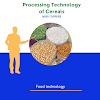FOOD PLANT SANITATION
Introduction:
The word sanitation is derived from the Latin word sanitas, meaning “health.” Applied to the food industry, sanitation is “the creation and maintenance of hygienic and healthful conditions.” It is the application of a science to provide wholesome food processed, prepared, merchandised, and sold in a clean environment by healthy workers; to prevent contamination with microorganisms that cause foodborne illness; and to minimize the proliferation of food spoilage microorganisms. Effective sanitation refers to all the procedures that help accomplish these goals.
Sanitation: An Applied Science
Sanitation is an applied science that incorporates the principles of design, development, implementation, maintenance, restoration, and/or improvement of hygienic practices and conditions.
Sanitation applications refer to hygienic practices designed to maintain a clean and wholesome environment for food production, processing, preparation, and storage. However, sanitation is more than just cleanliness. Done properly it can improve the aesthetic qualities and hygienic conditions of commercial operations, public facil-ities, and homes. Also, applied sanitary science can improve waste disposal which results in less pollution and an improved ecological balance. Therefore, when effectively applied, food sanitation and general sanitary practices have a beneficial effect on our environment.By identifying, evaluating, and controlling hazards and through the effective application of sanitary practices, a safe and wholesome food supply can be assured.
WHY SANITATION?
*An effective sanitation program can improve product quality and shelf life because the microbial population can be reduced.
*A well-developed and well-maintained sanitation program can increase the shelf life of
food.
*Satisfied and perhaps even delighted customers,
*Reduced public health risks,
*Increased trust of regulatory agen-cies and their inspectors,
*Decreased product waste and removal, and
*Improved employee morale
What is the aim of sanitationprogramme?
“ To exclude anything from a product that is not listed as an ingredient on its label ”
What are the principles & fundamentals of sanitation?
Sanitation mainly involves the following steps:
ERADICATION & Subsequent prevention of any existing insect and rodent infestation
PREVENTION of bacterial and mold contamination of finished goods
AVOIDENCE of conditions that might result in the introduction of extraneous materials intoi ingredientsand finished products.
APPROACHES OF SANITATION
1) The preventive sanitation:
• anticipation of problems & takes counter action before they develop
• Good housekeeping is the key a) M a i n t e n a n c e house keeping
b) Production housekeeping c) J a n i t o r i a l (building) house keeping
2) The corrective sanitation: finding solutions after observing problems
Importance of sanitation:
*Kills microorganisms already present
*Reduces potential contamination
*Minimizes chance of injury
*Prevents pest infestation
*Creates a more pleasant work environment















0 Comments
Send feedback